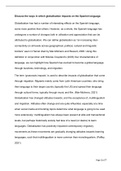Discuss the ways in which globalisation impacts on the Spanish language.
Globalisation has had a number of interesting effects on the Spanish language,
some more positive than others. However, as a whole, the Spanish language has
undergone a number of changes both in utilisation and appreciation that can be
attributed to globalisation. We can define globalisation as “an increasing inter-
connectivity on all levels across geographical, political, cultural and linguistic
borders” seen in Hamel cited by Mar-Molinero and Stewart, 2006. Using this
definition in conjunction with Nikolas Coupland’s (2003) four characteristics of
language, we can highlight how Spanish has evolved to become a global language
through business, technology, and migration.
The term ‘grassroots impacts’ is used to describe impacts of globalisation that come
through migration. Migrants mainly come from Latin American countries, who bring
their language to their target country (typically the US) and spread their language
through cultural forms, typically through music and film. (Mar-Molinero, 2021)
Globalisation has changed attitudes towards, and the acceptance of, multilingualism
and migration. Attitudes often change and are quite influential, especially at a time
when social media and trending topics determine what language is going to be used
more extensively; multilingualism has always been present at elite and transactional
levels, but perhaps historically society had less of a need (or desire) to learn
languages. Globalisation has positively impacted contemporary migratory
movements as these movements are gradually changing attitudes towards learning
languages, such that multilingualism is more common than monolingualism. (Paffey,
2021)
Page 1 of 7
, The benefits of globalisation are mostly seen in the developed world, as this is where
technology and communication processes are most advanced (Mar-Molinero and
Stewart, 2006). Thus, it makes sense that Coupland’s (2003) ‘disembedding’ (and
subsequently re-embedding) in terms of Spanish, primarily occurs in the US. This is
when a language is removed from where it originated and diversifies depending on
various social and geographical sites. A key example of ‘disembedding’, (Coupland,
2003), is codeswitching, which predominantly takes place in the US when Spanish
mixes with the dominant English language, with many calling this combination
‘Spanglish’. This term is when a language is removed from where it originated and
diversifies depending on various social and geographical sites. As a result of having
such a large Spanish speaking population, Spanish as a foreign language has
become extremely important in the US, compared to the UK and Europe where it is
typically English or French. Increasingly, there is an acceptance that Spanish is a
language in the US community, and so citizens must interact with it, either passively
or actively. (Mar-Molinero, 2010) This shows enormous potential for the maintenance
of Spanish in the US, as Spanish is more and more being used as a ‘commodity’
(Coupland, 2003) for business and diplomacy with Spanish speaking countries. This,
furthermore, allows for immigrants to maintain their native Spanish reasonably
easily, meaning newly migrated Spanish speakers are more likely to remain in close
contact with family and friends in their home countries. Increases in the numbers of
students enrolling in Spanish classes in American schools and the rise in popularity
of Spanish mass media also support the maintenance of the language (Tamasi and
Antieau, 2015, pp.209–224). Another way in which the Spanish language can be
considered to be a ‘commodity’ (Coupland, 2003) is on an individual basis when
trying to elevate one’s self-worth. Having competency in the Spanish language is
Page 2 of 7




